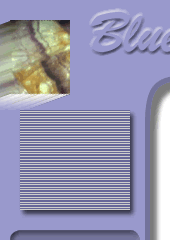 |
||
|
NEW:
Restoring a
Blue John Urn
Edward Fisher's
Masterpiece
Last Updated : Sat, 28-Jul-2007 © copyright 2001, 2007 HCI Data Ltd. |
||
 |
Out of the Blue
A tall display cabinet near the reception desk of Chappells Antiques Centre in Bakewell is full of exquisite objects made from one of the rarest minerals on earth: urns and goblets, pyramids and obelisks, vases and bowls, pendants and pebbles, all fashioned with care and precision from a form of flurospar which can only be found in the caverns and old lead mines of Treak Cliff, a hill one mile to the west of Castleton. Each ornamental piece in this fabulous collection has a smooth and highly polished surface that is kaleidoscopically patterned with zig zag bands of blue and yellow described as bleu-jaune in French, and translated into English as Blue John.
Just why this colourful stone should have been christened by the French, when it is so patently English, is something of a mystery, but this apparent contradiction is perhaps explained by the fact that some of the earliest Blue John ornaments were cut and polished in France. Its unique occurrence in the hidden depths of a Derbyshire hillside is an even greater mystery. Some geologists believe that Blue John was formed when hot gaseous material forced its way through cracks in the surface crust to react with the limestone. Others trace the characteristic banding of the stone to a layer of oil that became trapped between a reef of limestone and an overlying layer of gritstone.
Edward Leonard Fisher, the master craftsman who made every one of the objects in Chappells Antiques Centre's dazzling display, supports the latter theory. And he should know a thing or two about rocks, caves and mines, as he began working for his father, one of the last independent fluorospar miners in Derbyshire, when he was just 14 years old. Just one day after leaving school, he was labouring with a pick and shovel 330 feet below the White Peak plateau.
Eddie's one claim to fame at school had been the receipt of a handicraft prize for turning wood. In fact, he became so skilled that he fulfilled several commissions to make table lamps for his teachers. While working as a miner, he decided that he would use his manual talents to make some paperweights from barytes, a mineral found near Winster. But the stone he most wanted to fashion into useful objects and ornaments was Derbyshire's unique brand of fluorospar. He told me, "I've been in awe of Blue John ever since I first saw it in Castleton."
One day, Eddie was offered some Blue John stone if he was prepared to pay for the rare rocks by fashioning one of them into a chalice. He eagerly took up the challenge, designing his own machinery by copying that which he had seen in illustrations in books about Blue John. He duly fulfilled his commission, but not without his hands bleeding from the effort of moulding the stubborn mineral.
Eddie has been making Blue John ornaments for almost 30 years, all the while developing more and more sophisticated equipment of his own design. He prides himself on being the In only Blue John craftsman still manufacturing stemmed ornaments and on being a perfectionist. His goblets are strictly symmetrical; his pyramids are made in perfectly-matched pairs and his chalices are delicate without being vulnerable to easy breakage.
I was delighted to accept an invitation Eddie's workroom, where I watched him as he chiselled away the unwanted parts of a piece of crude fluorospar before heating it in an oven to drive off moisture - not too strongly, or the stone would turn yellow. After adding his own unique blend of toughening resin, the craftsman fashions the stone into a rough shape with a perfectly circular base. This is glued onto a nut, which is then attached to a lathe. While the stone turns slowly under the cooling effect of a spray of water, Eddie works at it with the skill and artistry of a master potter.
It so happened that my interview with Eddie took place on the day when he makes his weekly afternoon visit to Chappells Antiques Centre. I joined him in the showroom and watched in admiration as he took a cloth from above his display cabinet, opened the glass doors and carefully polished each piece in the collection. Rightly proud of his work, the master craftsman told me: "Lots of other people would like to make Blue John ornaments but it is very difficult to get hold of the rock because the supplies from Treak Cliff have almost been exhausted. In any case, most people who try to work the rock can't get the feel for the material." Anyone visiting Chappells Antiques Centre will recognise immediately that Eddie is one person who has the feel!
This article is © 2005 Living Edge Magazine Limited and has been reproduced with their kind permission.